Business in Practice: Types of Businesses, Ownership, and External Factors
VerifiedAdded on 2022/12/26
|10
|2489
|46
AI Summary
This document provides an in-depth analysis of different types of businesses, ownership structures, and how external factors impact a business. It includes a case study of Marks and Spencer, exploring its organizational structure and conducting a PESTEL analysis. The document offers valuable insights for understanding business practices and strategies.
Contribute Materials
Your contribution can guide someone’s learning journey. Share your
documents today.
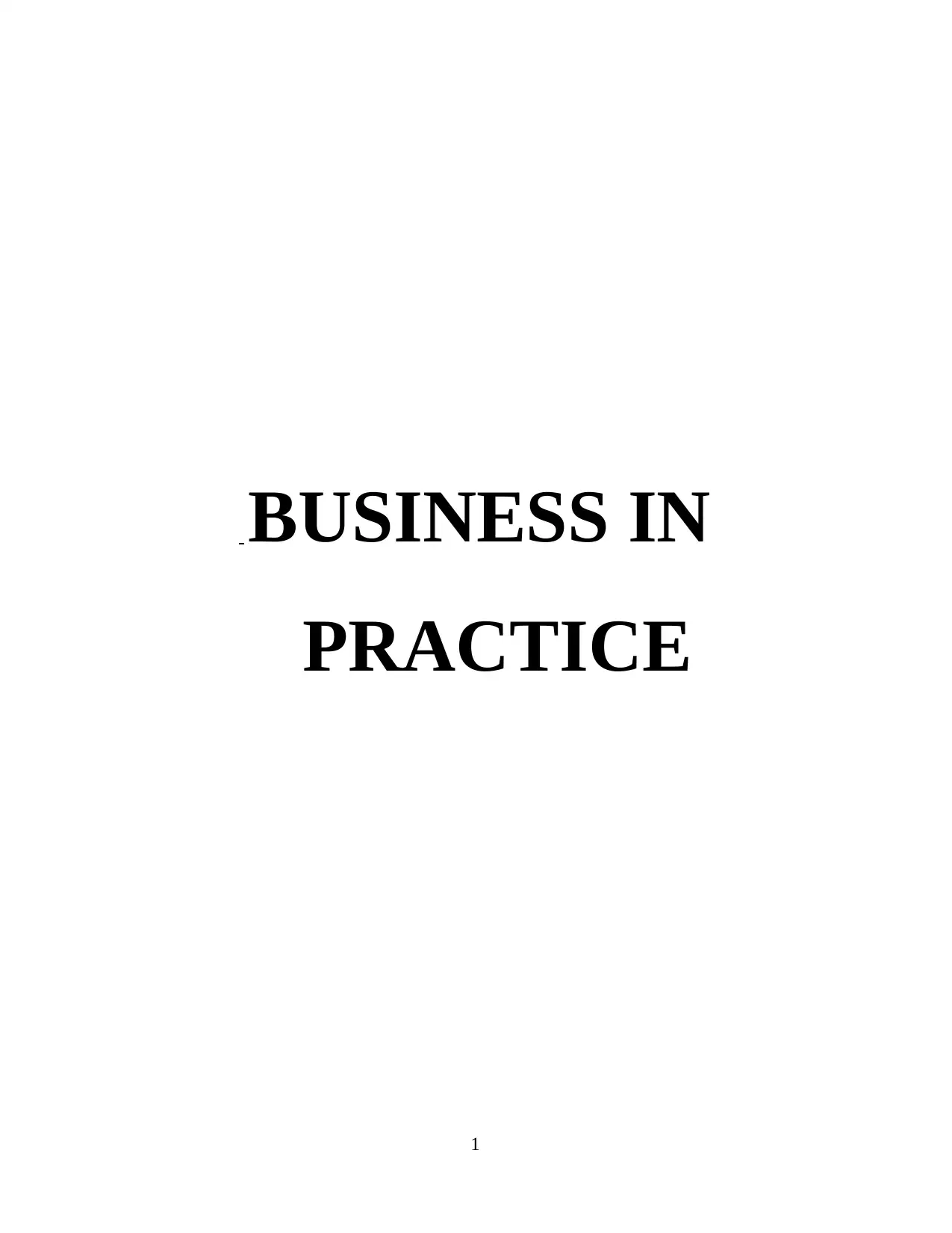
BUSINESS IN
PRACTICE
1
PRACTICE
1
Secure Best Marks with AI Grader
Need help grading? Try our AI Grader for instant feedback on your assignments.
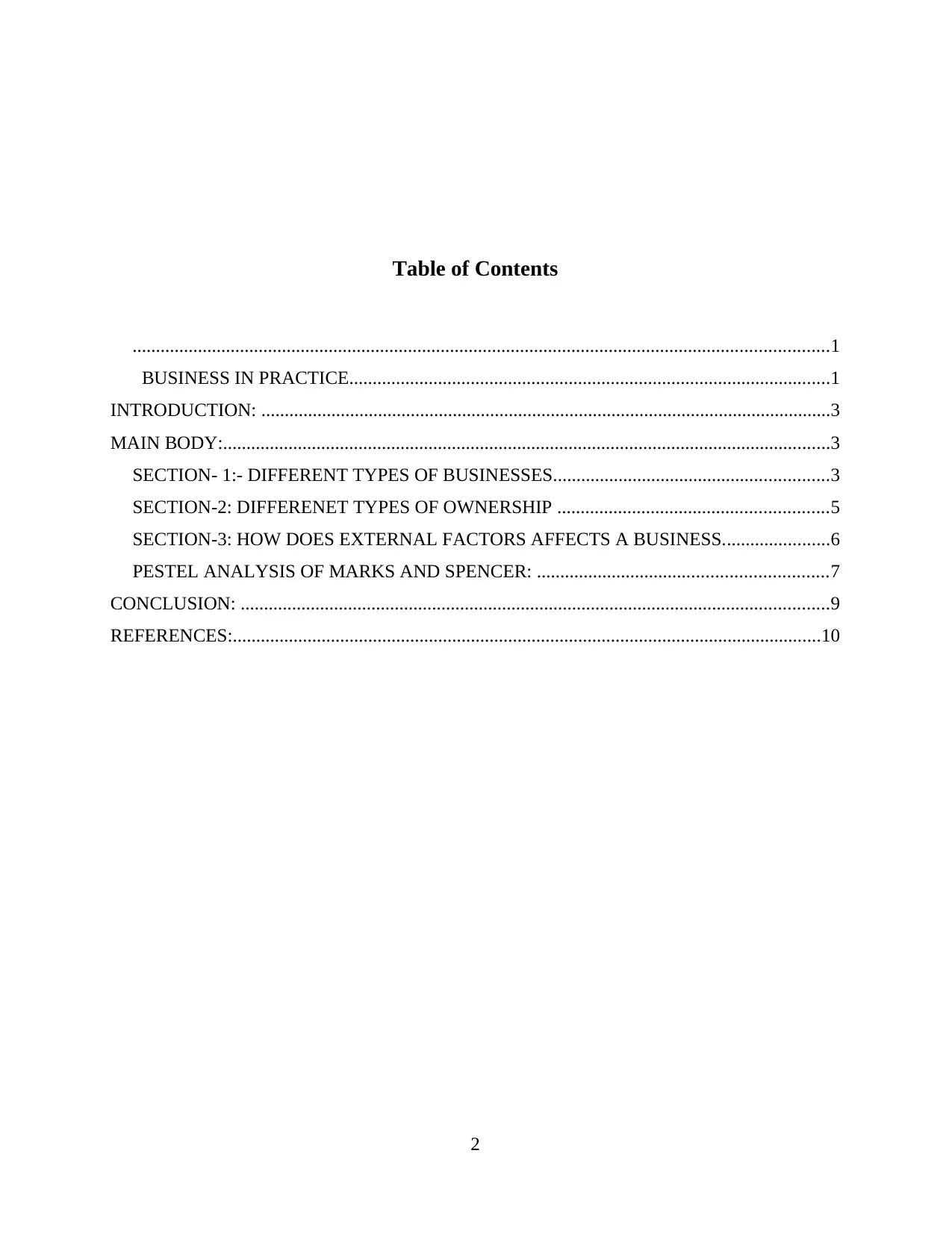
Table of Contents
.....................................................................................................................................................1
BUSINESS IN PRACTICE.......................................................................................................1
INTRODUCTION: ..........................................................................................................................3
MAIN BODY:..................................................................................................................................3
SECTION- 1:- DIFFERENT TYPES OF BUSINESSES...........................................................3
SECTION-2: DIFFERENET TYPES OF OWNERSHIP ..........................................................5
SECTION-3: HOW DOES EXTERNAL FACTORS AFFECTS A BUSINESS.......................6
PESTEL ANALYSIS OF MARKS AND SPENCER: ..............................................................7
CONCLUSION: ..............................................................................................................................9
REFERENCES:..............................................................................................................................10
2
.....................................................................................................................................................1
BUSINESS IN PRACTICE.......................................................................................................1
INTRODUCTION: ..........................................................................................................................3
MAIN BODY:..................................................................................................................................3
SECTION- 1:- DIFFERENT TYPES OF BUSINESSES...........................................................3
SECTION-2: DIFFERENET TYPES OF OWNERSHIP ..........................................................5
SECTION-3: HOW DOES EXTERNAL FACTORS AFFECTS A BUSINESS.......................6
PESTEL ANALYSIS OF MARKS AND SPENCER: ..............................................................7
CONCLUSION: ..............................................................................................................................9
REFERENCES:..............................................................................................................................10
2
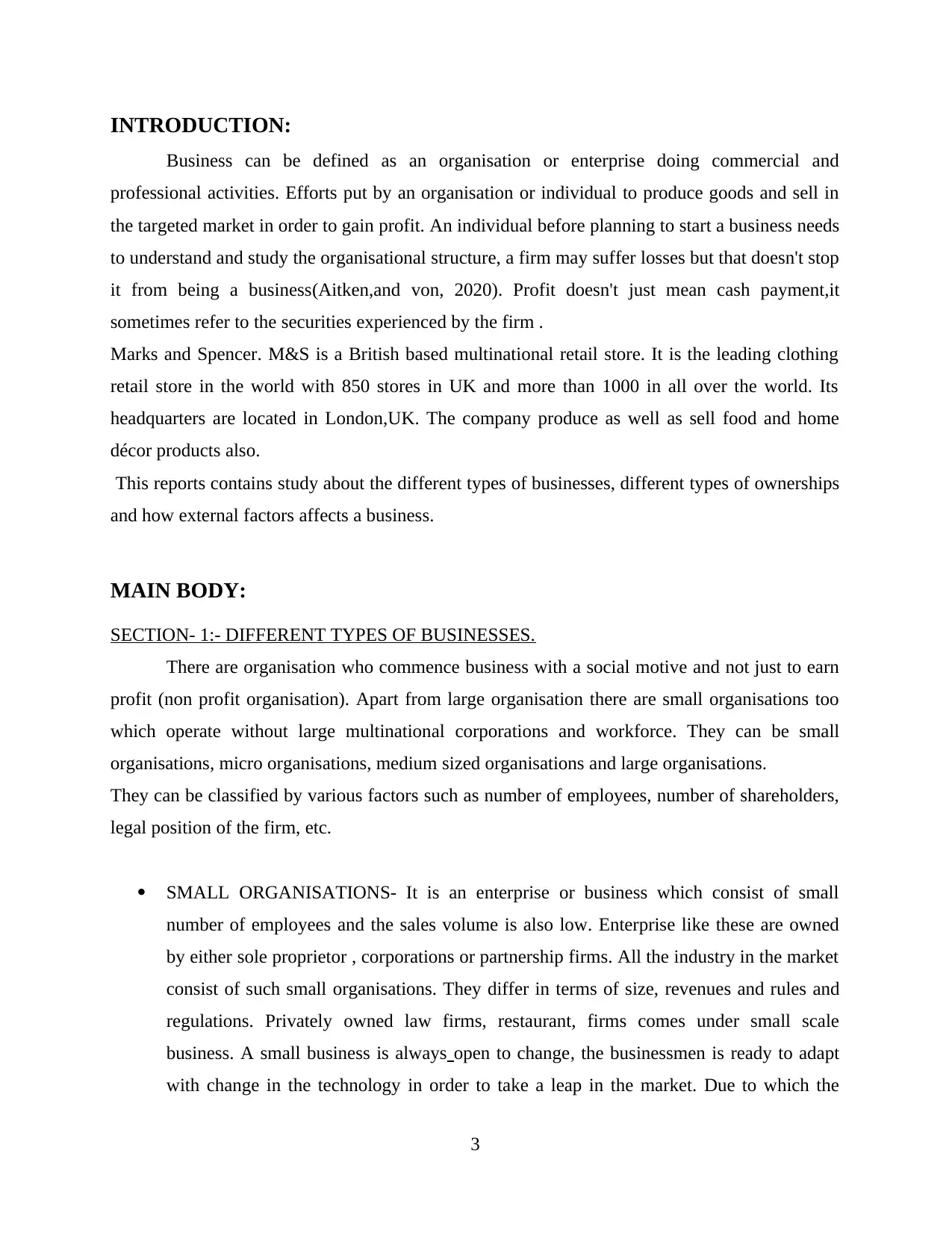
INTRODUCTION:
Business can be defined as an organisation or enterprise doing commercial and
professional activities. Efforts put by an organisation or individual to produce goods and sell in
the targeted market in order to gain profit. An individual before planning to start a business needs
to understand and study the organisational structure, a firm may suffer losses but that doesn't stop
it from being a business(Aitken,and von, 2020). Profit doesn't just mean cash payment,it
sometimes refer to the securities experienced by the firm .
Marks and Spencer. M&S is a British based multinational retail store. It is the leading clothing
retail store in the world with 850 stores in UK and more than 1000 in all over the world. Its
headquarters are located in London,UK. The company produce as well as sell food and home
décor products also.
This reports contains study about the different types of businesses, different types of ownerships
and how external factors affects a business.
MAIN BODY:
SECTION- 1:- DIFFERENT TYPES OF BUSINESSES.
There are organisation who commence business with a social motive and not just to earn
profit (non profit organisation). Apart from large organisation there are small organisations too
which operate without large multinational corporations and workforce. They can be small
organisations, micro organisations, medium sized organisations and large organisations.
They can be classified by various factors such as number of employees, number of shareholders,
legal position of the firm, etc.
SMALL ORGANISATIONS- It is an enterprise or business which consist of small
number of employees and the sales volume is also low. Enterprise like these are owned
by either sole proprietor , corporations or partnership firms. All the industry in the market
consist of such small organisations. They differ in terms of size, revenues and rules and
regulations. Privately owned law firms, restaurant, firms comes under small scale
business. A small business is always open to change, the businessmen is ready to adapt
with change in the technology in order to take a leap in the market. Due to which the
3
Business can be defined as an organisation or enterprise doing commercial and
professional activities. Efforts put by an organisation or individual to produce goods and sell in
the targeted market in order to gain profit. An individual before planning to start a business needs
to understand and study the organisational structure, a firm may suffer losses but that doesn't stop
it from being a business(Aitken,and von, 2020). Profit doesn't just mean cash payment,it
sometimes refer to the securities experienced by the firm .
Marks and Spencer. M&S is a British based multinational retail store. It is the leading clothing
retail store in the world with 850 stores in UK and more than 1000 in all over the world. Its
headquarters are located in London,UK. The company produce as well as sell food and home
décor products also.
This reports contains study about the different types of businesses, different types of ownerships
and how external factors affects a business.
MAIN BODY:
SECTION- 1:- DIFFERENT TYPES OF BUSINESSES.
There are organisation who commence business with a social motive and not just to earn
profit (non profit organisation). Apart from large organisation there are small organisations too
which operate without large multinational corporations and workforce. They can be small
organisations, micro organisations, medium sized organisations and large organisations.
They can be classified by various factors such as number of employees, number of shareholders,
legal position of the firm, etc.
SMALL ORGANISATIONS- It is an enterprise or business which consist of small
number of employees and the sales volume is also low. Enterprise like these are owned
by either sole proprietor , corporations or partnership firms. All the industry in the market
consist of such small organisations. They differ in terms of size, revenues and rules and
regulations. Privately owned law firms, restaurant, firms comes under small scale
business. A small business is always open to change, the businessmen is ready to adapt
with change in the technology in order to take a leap in the market. Due to which the
3
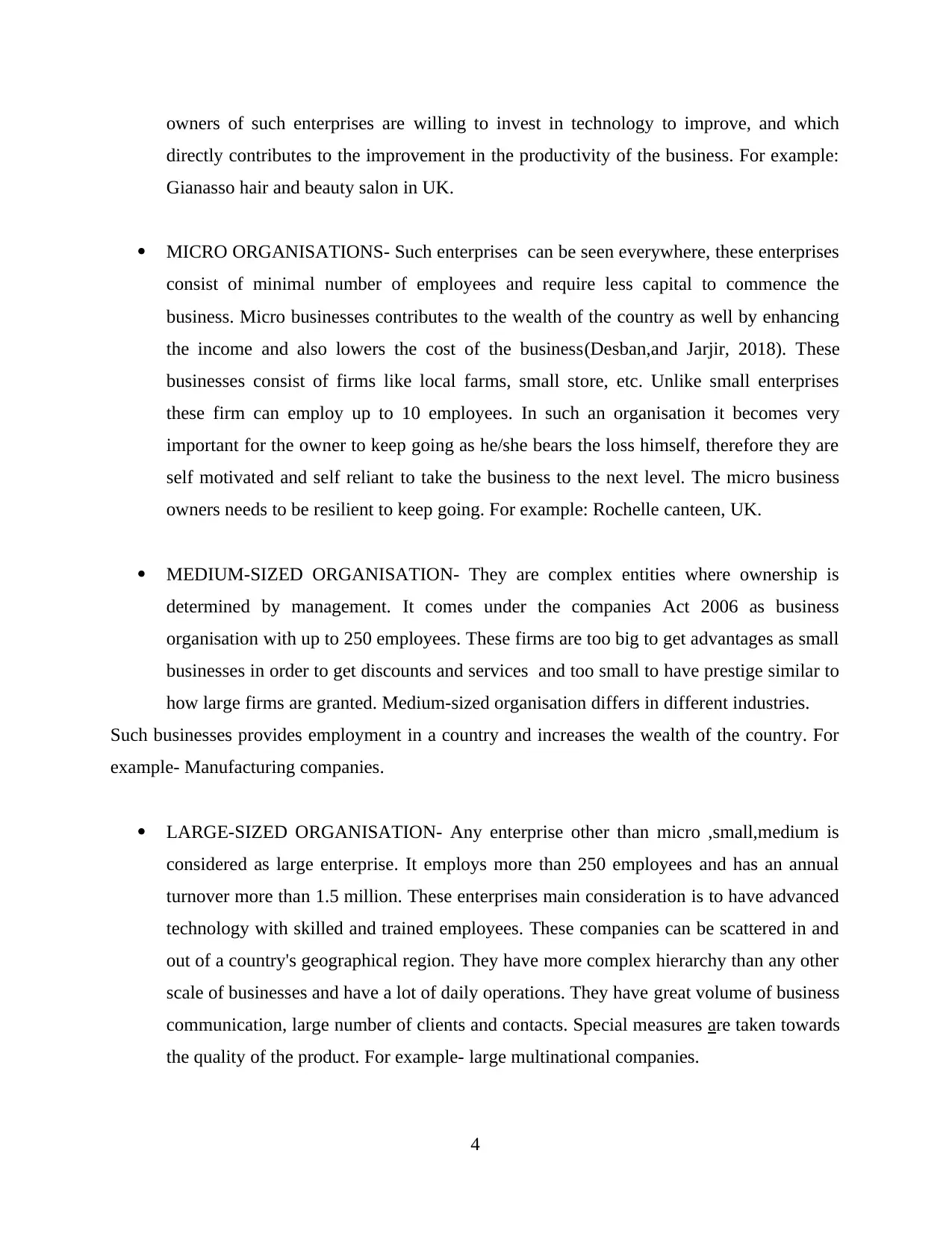
owners of such enterprises are willing to invest in technology to improve, and which
directly contributes to the improvement in the productivity of the business. For example:
Gianasso hair and beauty salon in UK.
MICRO ORGANISATIONS- Such enterprises can be seen everywhere, these enterprises
consist of minimal number of employees and require less capital to commence the
business. Micro businesses contributes to the wealth of the country as well by enhancing
the income and also lowers the cost of the business(Desban,and Jarjir, 2018). These
businesses consist of firms like local farms, small store, etc. Unlike small enterprises
these firm can employ up to 10 employees. In such an organisation it becomes very
important for the owner to keep going as he/she bears the loss himself, therefore they are
self motivated and self reliant to take the business to the next level. The micro business
owners needs to be resilient to keep going. For example: Rochelle canteen, UK.
MEDIUM-SIZED ORGANISATION- They are complex entities where ownership is
determined by management. It comes under the companies Act 2006 as business
organisation with up to 250 employees. These firms are too big to get advantages as small
businesses in order to get discounts and services and too small to have prestige similar to
how large firms are granted. Medium-sized organisation differs in different industries.
Such businesses provides employment in a country and increases the wealth of the country. For
example- Manufacturing companies.
LARGE-SIZED ORGANISATION- Any enterprise other than micro ,small,medium is
considered as large enterprise. It employs more than 250 employees and has an annual
turnover more than 1.5 million. These enterprises main consideration is to have advanced
technology with skilled and trained employees. These companies can be scattered in and
out of a country's geographical region. They have more complex hierarchy than any other
scale of businesses and have a lot of daily operations. They have great volume of business
communication, large number of clients and contacts. Special measures are taken towards
the quality of the product. For example- large multinational companies.
4
directly contributes to the improvement in the productivity of the business. For example:
Gianasso hair and beauty salon in UK.
MICRO ORGANISATIONS- Such enterprises can be seen everywhere, these enterprises
consist of minimal number of employees and require less capital to commence the
business. Micro businesses contributes to the wealth of the country as well by enhancing
the income and also lowers the cost of the business(Desban,and Jarjir, 2018). These
businesses consist of firms like local farms, small store, etc. Unlike small enterprises
these firm can employ up to 10 employees. In such an organisation it becomes very
important for the owner to keep going as he/she bears the loss himself, therefore they are
self motivated and self reliant to take the business to the next level. The micro business
owners needs to be resilient to keep going. For example: Rochelle canteen, UK.
MEDIUM-SIZED ORGANISATION- They are complex entities where ownership is
determined by management. It comes under the companies Act 2006 as business
organisation with up to 250 employees. These firms are too big to get advantages as small
businesses in order to get discounts and services and too small to have prestige similar to
how large firms are granted. Medium-sized organisation differs in different industries.
Such businesses provides employment in a country and increases the wealth of the country. For
example- Manufacturing companies.
LARGE-SIZED ORGANISATION- Any enterprise other than micro ,small,medium is
considered as large enterprise. It employs more than 250 employees and has an annual
turnover more than 1.5 million. These enterprises main consideration is to have advanced
technology with skilled and trained employees. These companies can be scattered in and
out of a country's geographical region. They have more complex hierarchy than any other
scale of businesses and have a lot of daily operations. They have great volume of business
communication, large number of clients and contacts. Special measures are taken towards
the quality of the product. For example- large multinational companies.
4
Secure Best Marks with AI Grader
Need help grading? Try our AI Grader for instant feedback on your assignments.
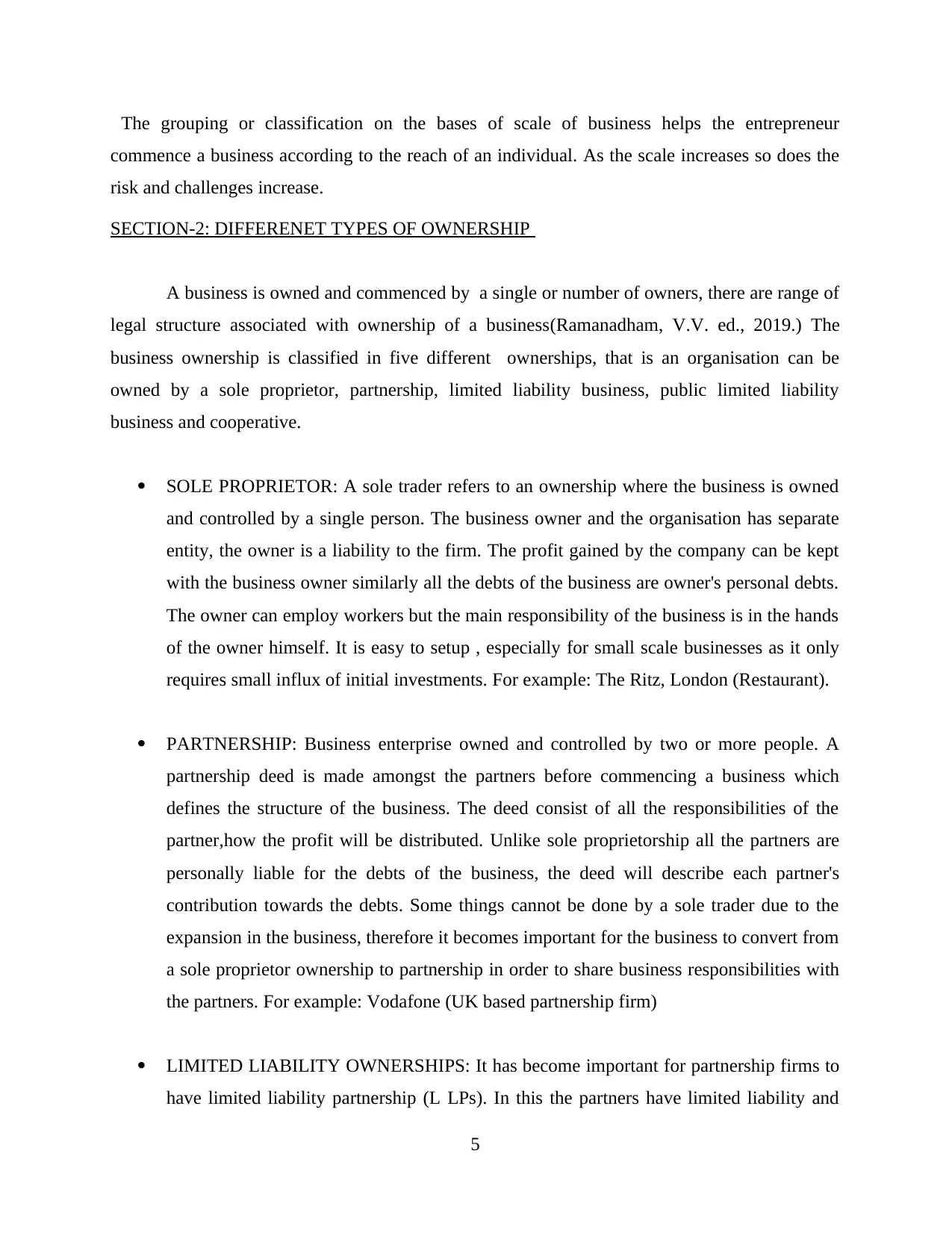
The grouping or classification on the bases of scale of business helps the entrepreneur
commence a business according to the reach of an individual. As the scale increases so does the
risk and challenges increase.
SECTION-2: DIFFERENET TYPES OF OWNERSHIP
A business is owned and commenced by a single or number of owners, there are range of
legal structure associated with ownership of a business(Ramanadham, V.V. ed., 2019.) The
business ownership is classified in five different ownerships, that is an organisation can be
owned by a sole proprietor, partnership, limited liability business, public limited liability
business and cooperative.
SOLE PROPRIETOR: A sole trader refers to an ownership where the business is owned
and controlled by a single person. The business owner and the organisation has separate
entity, the owner is a liability to the firm. The profit gained by the company can be kept
with the business owner similarly all the debts of the business are owner's personal debts.
The owner can employ workers but the main responsibility of the business is in the hands
of the owner himself. It is easy to setup , especially for small scale businesses as it only
requires small influx of initial investments. For example: The Ritz, London (Restaurant).
PARTNERSHIP: Business enterprise owned and controlled by two or more people. A
partnership deed is made amongst the partners before commencing a business which
defines the structure of the business. The deed consist of all the responsibilities of the
partner,how the profit will be distributed. Unlike sole proprietorship all the partners are
personally liable for the debts of the business, the deed will describe each partner's
contribution towards the debts. Some things cannot be done by a sole trader due to the
expansion in the business, therefore it becomes important for the business to convert from
a sole proprietor ownership to partnership in order to share business responsibilities with
the partners. For example: Vodafone (UK based partnership firm)
LIMITED LIABILITY OWNERSHIPS: It has become important for partnership firms to
have limited liability partnership (L LPs). In this the partners have limited liability and
5
commence a business according to the reach of an individual. As the scale increases so does the
risk and challenges increase.
SECTION-2: DIFFERENET TYPES OF OWNERSHIP
A business is owned and commenced by a single or number of owners, there are range of
legal structure associated with ownership of a business(Ramanadham, V.V. ed., 2019.) The
business ownership is classified in five different ownerships, that is an organisation can be
owned by a sole proprietor, partnership, limited liability business, public limited liability
business and cooperative.
SOLE PROPRIETOR: A sole trader refers to an ownership where the business is owned
and controlled by a single person. The business owner and the organisation has separate
entity, the owner is a liability to the firm. The profit gained by the company can be kept
with the business owner similarly all the debts of the business are owner's personal debts.
The owner can employ workers but the main responsibility of the business is in the hands
of the owner himself. It is easy to setup , especially for small scale businesses as it only
requires small influx of initial investments. For example: The Ritz, London (Restaurant).
PARTNERSHIP: Business enterprise owned and controlled by two or more people. A
partnership deed is made amongst the partners before commencing a business which
defines the structure of the business. The deed consist of all the responsibilities of the
partner,how the profit will be distributed. Unlike sole proprietorship all the partners are
personally liable for the debts of the business, the deed will describe each partner's
contribution towards the debts. Some things cannot be done by a sole trader due to the
expansion in the business, therefore it becomes important for the business to convert from
a sole proprietor ownership to partnership in order to share business responsibilities with
the partners. For example: Vodafone (UK based partnership firm)
LIMITED LIABILITY OWNERSHIPS: It has become important for partnership firms to
have limited liability partnership (L LPs). In this the partners have limited liability and
5
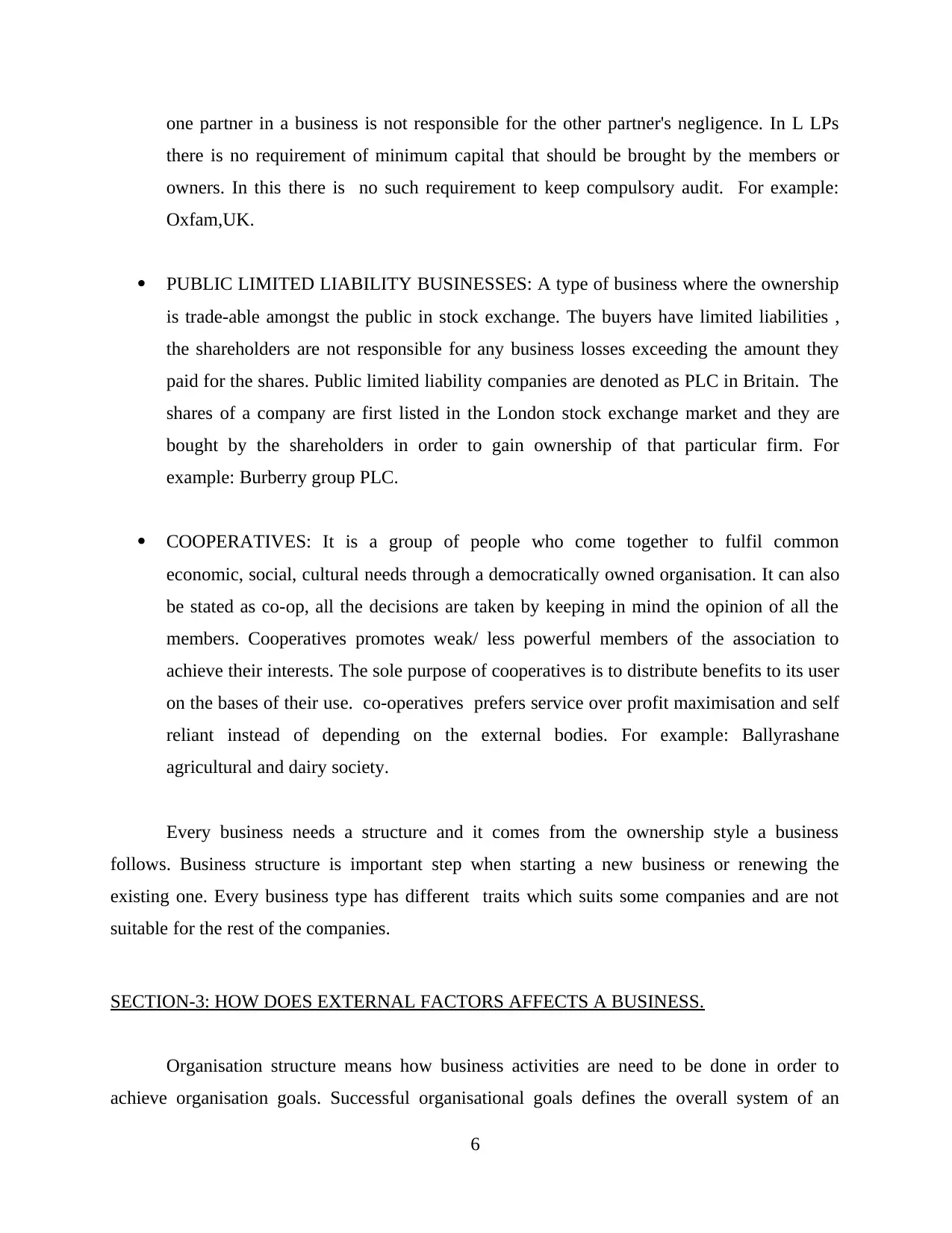
one partner in a business is not responsible for the other partner's negligence. In L LPs
there is no requirement of minimum capital that should be brought by the members or
owners. In this there is no such requirement to keep compulsory audit. For example:
Oxfam,UK.
PUBLIC LIMITED LIABILITY BUSINESSES: A type of business where the ownership
is trade-able amongst the public in stock exchange. The buyers have limited liabilities ,
the shareholders are not responsible for any business losses exceeding the amount they
paid for the shares. Public limited liability companies are denoted as PLC in Britain. The
shares of a company are first listed in the London stock exchange market and they are
bought by the shareholders in order to gain ownership of that particular firm. For
example: Burberry group PLC.
COOPERATIVES: It is a group of people who come together to fulfil common
economic, social, cultural needs through a democratically owned organisation. It can also
be stated as co-op, all the decisions are taken by keeping in mind the opinion of all the
members. Cooperatives promotes weak/ less powerful members of the association to
achieve their interests. The sole purpose of cooperatives is to distribute benefits to its user
on the bases of their use. co-operatives prefers service over profit maximisation and self
reliant instead of depending on the external bodies. For example: Ballyrashane
agricultural and dairy society.
Every business needs a structure and it comes from the ownership style a business
follows. Business structure is important step when starting a new business or renewing the
existing one. Every business type has different traits which suits some companies and are not
suitable for the rest of the companies.
SECTION-3: HOW DOES EXTERNAL FACTORS AFFECTS A BUSINESS.
Organisation structure means how business activities are need to be done in order to
achieve organisation goals. Successful organisational goals defines the overall system of an
6
there is no requirement of minimum capital that should be brought by the members or
owners. In this there is no such requirement to keep compulsory audit. For example:
Oxfam,UK.
PUBLIC LIMITED LIABILITY BUSINESSES: A type of business where the ownership
is trade-able amongst the public in stock exchange. The buyers have limited liabilities ,
the shareholders are not responsible for any business losses exceeding the amount they
paid for the shares. Public limited liability companies are denoted as PLC in Britain. The
shares of a company are first listed in the London stock exchange market and they are
bought by the shareholders in order to gain ownership of that particular firm. For
example: Burberry group PLC.
COOPERATIVES: It is a group of people who come together to fulfil common
economic, social, cultural needs through a democratically owned organisation. It can also
be stated as co-op, all the decisions are taken by keeping in mind the opinion of all the
members. Cooperatives promotes weak/ less powerful members of the association to
achieve their interests. The sole purpose of cooperatives is to distribute benefits to its user
on the bases of their use. co-operatives prefers service over profit maximisation and self
reliant instead of depending on the external bodies. For example: Ballyrashane
agricultural and dairy society.
Every business needs a structure and it comes from the ownership style a business
follows. Business structure is important step when starting a new business or renewing the
existing one. Every business type has different traits which suits some companies and are not
suitable for the rest of the companies.
SECTION-3: HOW DOES EXTERNAL FACTORS AFFECTS A BUSINESS.
Organisation structure means how business activities are need to be done in order to
achieve organisation goals. Successful organisational goals defines the overall system of an
6
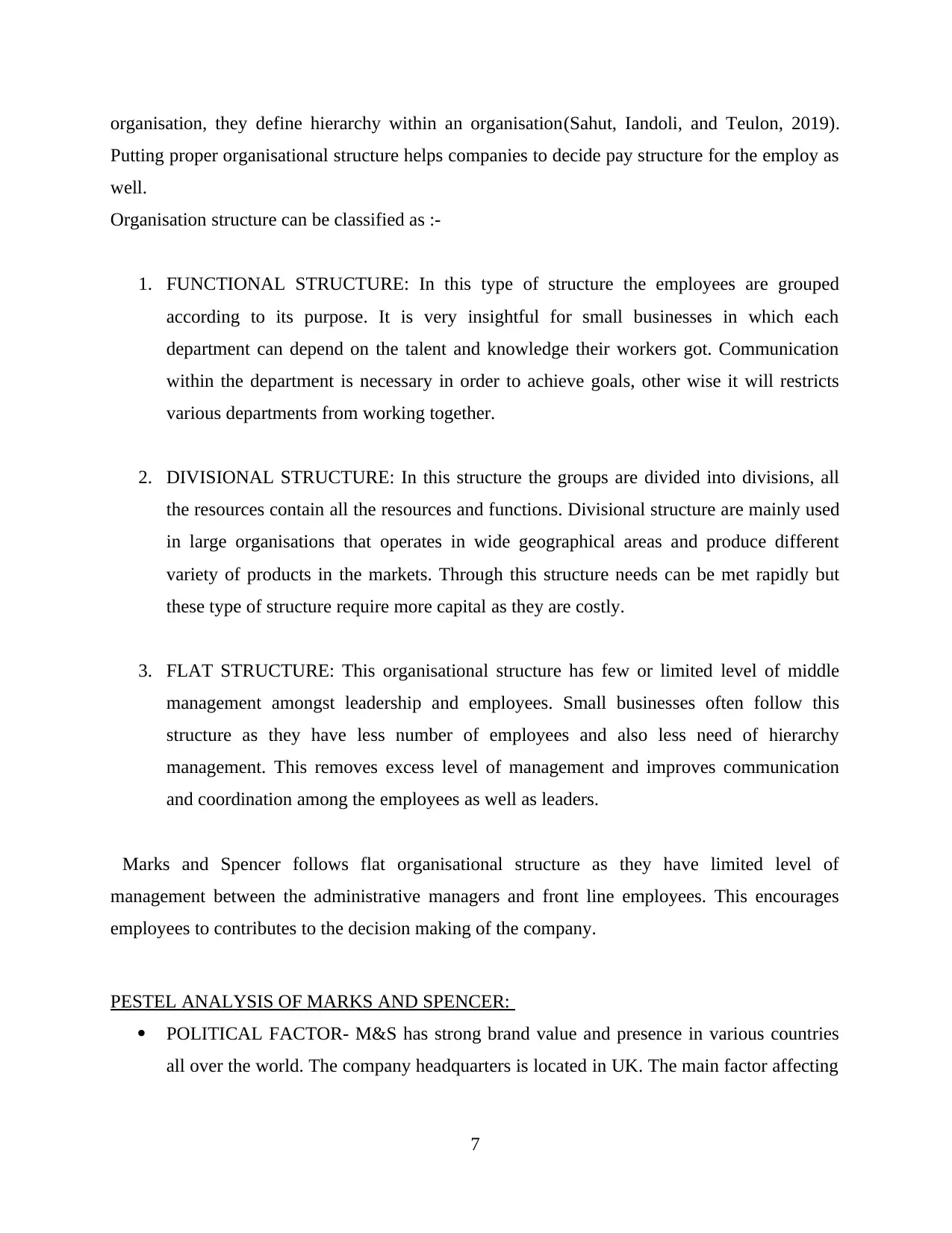
organisation, they define hierarchy within an organisation(Sahut, Iandoli, and Teulon, 2019).
Putting proper organisational structure helps companies to decide pay structure for the employ as
well.
Organisation structure can be classified as :-
1. FUNCTIONAL STRUCTURE: In this type of structure the employees are grouped
according to its purpose. It is very insightful for small businesses in which each
department can depend on the talent and knowledge their workers got. Communication
within the department is necessary in order to achieve goals, other wise it will restricts
various departments from working together.
2. DIVISIONAL STRUCTURE: In this structure the groups are divided into divisions, all
the resources contain all the resources and functions. Divisional structure are mainly used
in large organisations that operates in wide geographical areas and produce different
variety of products in the markets. Through this structure needs can be met rapidly but
these type of structure require more capital as they are costly.
3. FLAT STRUCTURE: This organisational structure has few or limited level of middle
management amongst leadership and employees. Small businesses often follow this
structure as they have less number of employees and also less need of hierarchy
management. This removes excess level of management and improves communication
and coordination among the employees as well as leaders.
Marks and Spencer follows flat organisational structure as they have limited level of
management between the administrative managers and front line employees. This encourages
employees to contributes to the decision making of the company.
PESTEL ANALYSIS OF MARKS AND SPENCER:
POLITICAL FACTOR- M&S has strong brand value and presence in various countries
all over the world. The company headquarters is located in UK. The main factor affecting
7
Putting proper organisational structure helps companies to decide pay structure for the employ as
well.
Organisation structure can be classified as :-
1. FUNCTIONAL STRUCTURE: In this type of structure the employees are grouped
according to its purpose. It is very insightful for small businesses in which each
department can depend on the talent and knowledge their workers got. Communication
within the department is necessary in order to achieve goals, other wise it will restricts
various departments from working together.
2. DIVISIONAL STRUCTURE: In this structure the groups are divided into divisions, all
the resources contain all the resources and functions. Divisional structure are mainly used
in large organisations that operates in wide geographical areas and produce different
variety of products in the markets. Through this structure needs can be met rapidly but
these type of structure require more capital as they are costly.
3. FLAT STRUCTURE: This organisational structure has few or limited level of middle
management amongst leadership and employees. Small businesses often follow this
structure as they have less number of employees and also less need of hierarchy
management. This removes excess level of management and improves communication
and coordination among the employees as well as leaders.
Marks and Spencer follows flat organisational structure as they have limited level of
management between the administrative managers and front line employees. This encourages
employees to contributes to the decision making of the company.
PESTEL ANALYSIS OF MARKS AND SPENCER:
POLITICAL FACTOR- M&S has strong brand value and presence in various countries
all over the world. The company headquarters is located in UK. The main factor affecting
7
Paraphrase This Document
Need a fresh take? Get an instant paraphrase of this document with our AI Paraphraser
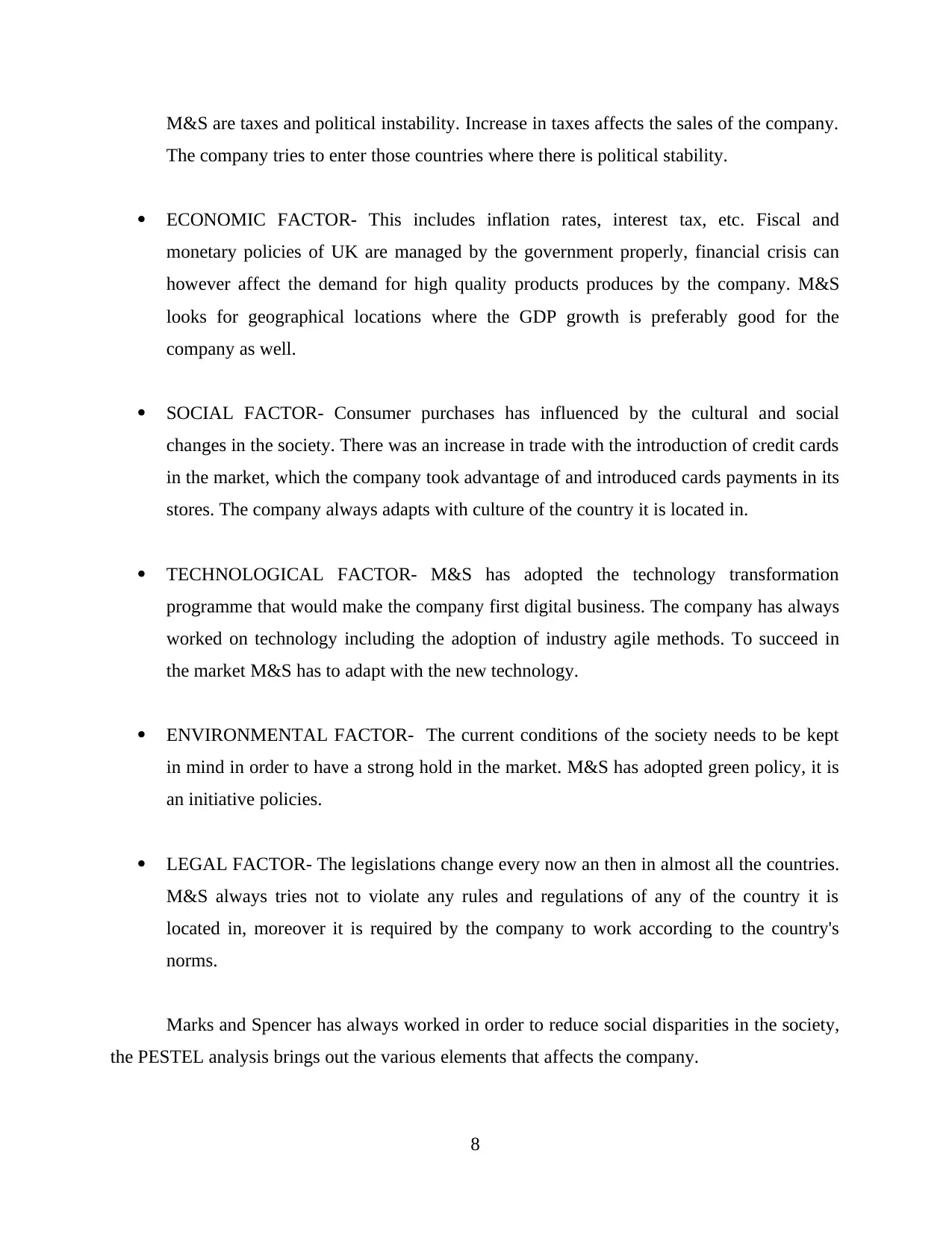
M&S are taxes and political instability. Increase in taxes affects the sales of the company.
The company tries to enter those countries where there is political stability.
ECONOMIC FACTOR- This includes inflation rates, interest tax, etc. Fiscal and
monetary policies of UK are managed by the government properly, financial crisis can
however affect the demand for high quality products produces by the company. M&S
looks for geographical locations where the GDP growth is preferably good for the
company as well.
SOCIAL FACTOR- Consumer purchases has influenced by the cultural and social
changes in the society. There was an increase in trade with the introduction of credit cards
in the market, which the company took advantage of and introduced cards payments in its
stores. The company always adapts with culture of the country it is located in.
TECHNOLOGICAL FACTOR- M&S has adopted the technology transformation
programme that would make the company first digital business. The company has always
worked on technology including the adoption of industry agile methods. To succeed in
the market M&S has to adapt with the new technology.
ENVIRONMENTAL FACTOR- The current conditions of the society needs to be kept
in mind in order to have a strong hold in the market. M&S has adopted green policy, it is
an initiative policies.
LEGAL FACTOR- The legislations change every now an then in almost all the countries.
M&S always tries not to violate any rules and regulations of any of the country it is
located in, moreover it is required by the company to work according to the country's
norms.
Marks and Spencer has always worked in order to reduce social disparities in the society,
the PESTEL analysis brings out the various elements that affects the company.
8
The company tries to enter those countries where there is political stability.
ECONOMIC FACTOR- This includes inflation rates, interest tax, etc. Fiscal and
monetary policies of UK are managed by the government properly, financial crisis can
however affect the demand for high quality products produces by the company. M&S
looks for geographical locations where the GDP growth is preferably good for the
company as well.
SOCIAL FACTOR- Consumer purchases has influenced by the cultural and social
changes in the society. There was an increase in trade with the introduction of credit cards
in the market, which the company took advantage of and introduced cards payments in its
stores. The company always adapts with culture of the country it is located in.
TECHNOLOGICAL FACTOR- M&S has adopted the technology transformation
programme that would make the company first digital business. The company has always
worked on technology including the adoption of industry agile methods. To succeed in
the market M&S has to adapt with the new technology.
ENVIRONMENTAL FACTOR- The current conditions of the society needs to be kept
in mind in order to have a strong hold in the market. M&S has adopted green policy, it is
an initiative policies.
LEGAL FACTOR- The legislations change every now an then in almost all the countries.
M&S always tries not to violate any rules and regulations of any of the country it is
located in, moreover it is required by the company to work according to the country's
norms.
Marks and Spencer has always worked in order to reduce social disparities in the society,
the PESTEL analysis brings out the various elements that affects the company.
8
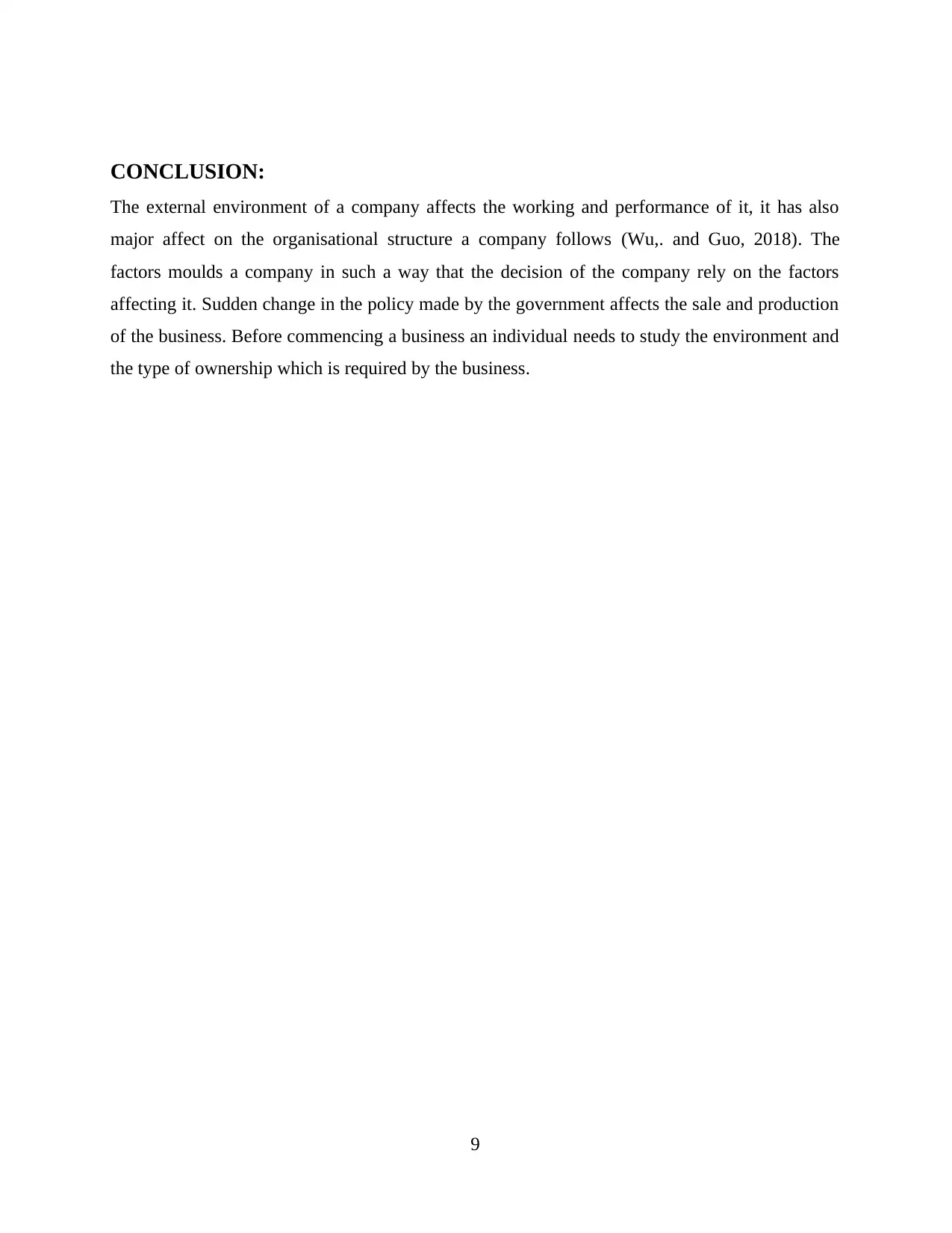
CONCLUSION:
The external environment of a company affects the working and performance of it, it has also
major affect on the organisational structure a company follows (Wu,. and Guo, 2018). The
factors moulds a company in such a way that the decision of the company rely on the factors
affecting it. Sudden change in the policy made by the government affects the sale and production
of the business. Before commencing a business an individual needs to study the environment and
the type of ownership which is required by the business.
9
The external environment of a company affects the working and performance of it, it has also
major affect on the organisational structure a company follows (Wu,. and Guo, 2018). The
factors moulds a company in such a way that the decision of the company rely on the factors
affecting it. Sudden change in the policy made by the government affects the sale and production
of the business. Before commencing a business an individual needs to study the environment and
the type of ownership which is required by the business.
9
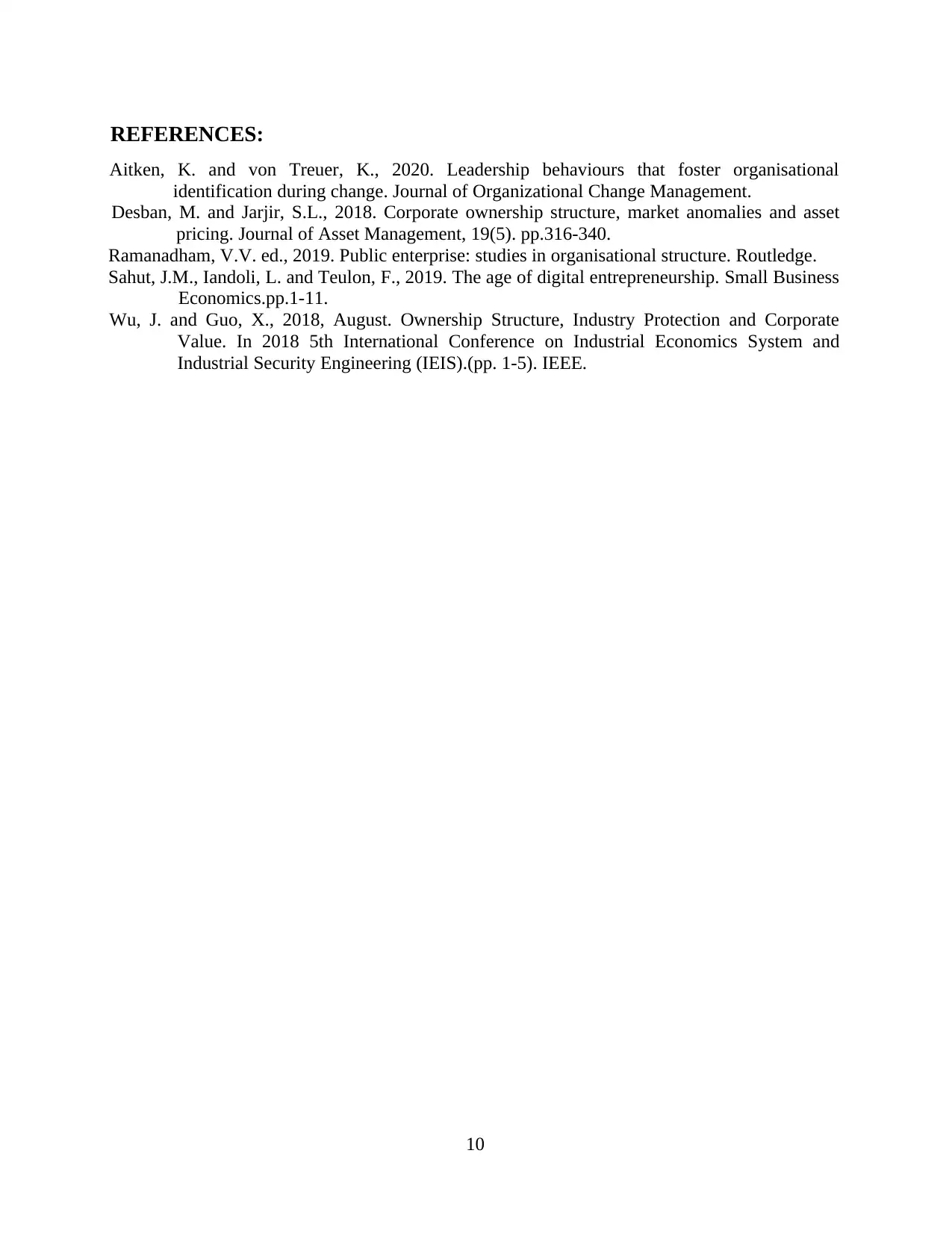
REFERENCES:
Aitken, K. and von Treuer, K., 2020. Leadership behaviours that foster organisational
identification during change. Journal of Organizational Change Management.
Desban, M. and Jarjir, S.L., 2018. Corporate ownership structure, market anomalies and asset
pricing. Journal of Asset Management, 19(5). pp.316-340.
Ramanadham, V.V. ed., 2019. Public enterprise: studies in organisational structure. Routledge.
Sahut, J.M., Iandoli, L. and Teulon, F., 2019. The age of digital entrepreneurship. Small Business
Economics.pp.1-11.
Wu, J. and Guo, X., 2018, August. Ownership Structure, Industry Protection and Corporate
Value. In 2018 5th International Conference on Industrial Economics System and
Industrial Security Engineering (IEIS).(pp. 1-5). IEEE.
10
Aitken, K. and von Treuer, K., 2020. Leadership behaviours that foster organisational
identification during change. Journal of Organizational Change Management.
Desban, M. and Jarjir, S.L., 2018. Corporate ownership structure, market anomalies and asset
pricing. Journal of Asset Management, 19(5). pp.316-340.
Ramanadham, V.V. ed., 2019. Public enterprise: studies in organisational structure. Routledge.
Sahut, J.M., Iandoli, L. and Teulon, F., 2019. The age of digital entrepreneurship. Small Business
Economics.pp.1-11.
Wu, J. and Guo, X., 2018, August. Ownership Structure, Industry Protection and Corporate
Value. In 2018 5th International Conference on Industrial Economics System and
Industrial Security Engineering (IEIS).(pp. 1-5). IEEE.
10
1 out of 10
Related Documents
Your All-in-One AI-Powered Toolkit for Academic Success.
+13062052269
info@desklib.com
Available 24*7 on WhatsApp / Email
![[object Object]](/_next/static/media/star-bottom.7253800d.svg)
Unlock your academic potential
© 2024 | Zucol Services PVT LTD | All rights reserved.





